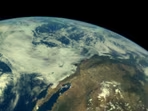Fire Once Helped Sequoias Reproduce. Now, it’s Killing the Groves.
Giant sequoia groves in California’s Sequoia and Kings Canyon National Parks that were extensively burned in the megafires of 2020 and 2021 produced numbers of seedlings that were so “drastically low” in some areas that they may not naturally regenerate, according to two new studies by government scientists.
One of the studies, by researchers with the U.S. Geological Survey’s Western Ecological Research Center and published in the journal Ecosphere in March, tried to assess the “likelihood of natural recovery” in four Sequoia groves and found that “seedling densities fell far below the average density measured after prescribed fires” that were intentionally set to maintain grove regeneration and health.
In the second study, published last month in Forest Ecology and Management, the researchers developed “seedling reference densities” based on post-fire data from eight groves that burned in 26 different fires in the national parks from 1969 to 2016 to identify areas that might require planting by forest managers. In one “case-study sequoia grove” burned in one of the recent high-severity wildfires, the study found seedling densities that were “significantly (and dramatically) lower” than historic norms, “suggesting inadequate post-fire reproduction.”
The studies found that extreme wildfires have killed up to 20 percent of the world’s mature giant sequoias since 2015, with a majority of the trees dying in three wildfires in 2020 and 2021. The sequoias are the largest trees in the world and among the oldest, and only grow on the western slopes of the Sierra Nevada in California, according to the National Park Service.
Explore the latest news about what’s at stake for the climate during this election season.
The groves store massive amounts of carbon, second to old-growth coast redwood forests, which exclusively grow in a narrow band along the West Coast from southern Oregon to Central California. Because of their enormity and longevity, a single sequoia can store up to 86 years’ worth of a human’s carbon emissions. By storing this greenhouse gas out of the atmosphere, giant sequoias help fight climate change.
Despite their ability to store carbon, the trees are struggling to adapt to new climate conditions.
Seedlings that managed to germinate after the wildfires faced higher average temperatures and “the most severe drought conditions of the 121-year historical record,” according to the Save the Redwoods League, which announced the studies last week. The league said natural recovery “will almost certainly be greatly diminished” in areas where the mature sequoias died.
“Sequoia regeneration has varied widely across the range since the recent mega-fires,” said David Soderberg, lead author of the first study and Ph.D. ecologist, also at the USGS western research center. “Some areas are doing well, but in other sites where the seeds and seed trees burned, or where young seedlings have died from high heat and drought, natural long-term recovery appears to be unlikely. Our data suggest that sequoia grove areas that were severely impacted by the fires may not have enough reproduction to replace the sequoias lost.”
The study explains how fires typically aid reproduction by exposing mineral soil and opening the canopy for light penetration. The heat from the flames also releases seeds from the trees’ cones. Yet, this only happens when fires are episodic—not constant. With more frequent high-severity fires entirely consuming seedlings and mature sequoia groves, the giant trees can’t recover fast enough, the study says.
The researchers found these results by surveying the four Sequoia and Kings Canyon National Parks groves impacted by high-severity wildfires in 2020 and 2021. On various plots within these groves, they counted seedlings under 1.37 meters in height that regenerated post-fire. After assessing how many sequoia seedlings survived, the team surveyed mapped giant sequoia trees, recording their status (live versus dead) and the percentage of its crown that was alive, scorched or torched.
The study found that “in the context of a large, high-severity burn where the vast majority of large trees have died, the clumped nature of giant sequoia seedlings might be highly concerning.” If the seedlings are too dense, it reduces their ability to survive because they need ample space to fully mature. Hence, the seedlings must be more widely distributed for the grove to effectively be restored.
“What we used to call high-severity fire does not compare to the unprecedented scale and severity of the wildfires we’ve experienced in recent years in the Sierra Nevada.”
Understanding this spatial pattern is critical for forest managers to assess the fire risk to groves, the study found.
Under the constant threat of wildfires, the giant sequoia tree evolved to be more resilient to wildfire by growing thick bark that protects their trunks from flames and branches that rise far above fires burning on the ground, as well as using fires to reproduce. Yet, their adaptations are not enough anymore.
“Recent fires have killed thousands of mature trees and, in some cases, their seeds too,” said Nathan Stephenson, lead author of the June study and a Ph.D. scientist emeritus at the USGS western research center. “What we used to call high-severity fire does not compare to the unprecedented scale and severity of the wildfires we’ve experienced in recent years in the Sierra Nevada.”
For the groves to make a full recovery, they need some help from forest managers. As the March study in Ecosphere explains, managers must understand spatial patterns as well as seedling density, or how many seedlings exist per area. Elaborating on the spacing of seedlings, the June study uses density calculations to estimate how many seedlings need to be planted to adequately restore a specific grove.
The study lists “five criteria for reference densities—criteria that, in current practice, are rarely all met.” Those criteria are post-fire reproduction, both year-by-year and during the first few years after a fire, taking uncertainty with estimates into account as well as changes in the environment, including temperature and drought. After every fire, using these criteria allows an accurate assessment of the seedling reference, so they can compare how many seedlings are growing in a burned area to how many would have been expected there before the warming climate increased the temperature, aridity and severity of wildfires burning there.
Both of these studies are equipping forest managers with the science-backed information needed to restore the giant sequoia groves after fires. However, both note that as the environment continues to change, research will have to adapt along with it.
About This Story
Perhaps you noticed: This story, like all the news we publish, is free to read. That’s because Inside Climate News is a 501c3 nonprofit organization. We do not charge a subscription fee, lock our news behind a paywall, or clutter our website with ads. We make our news on climate and the environment freely available to you and anyone who wants it.
That’s not all. We also share our news for free with scores of other media organizations around the country. Many of them can’t afford to do environmental journalism of their own. We’ve built bureaus from coast to coast to report local stories, collaborate with local newsrooms and co-publish articles so that this vital work is shared as widely as possible.
Two of us launched ICN in 2007. Six years later we earned a Pulitzer Prize for National Reporting, and now we run the oldest and largest dedicated climate newsroom in the nation. We tell the story in all its complexity. We hold polluters accountable. We expose environmental injustice. We debunk misinformation. We scrutinize solutions and inspire action.
Donations from readers like you fund every aspect of what we do. If you don’t already, will you support our ongoing work, our reporting on the biggest crisis facing our planet, and help us reach even more readers in more places?
Please take a moment to make a tax-deductible donation. Every one of them makes a difference.
Thank you,
David Sassoon
Founder and Publisher
Vernon Loeb
Executive Editor
Share this article
Disclaimer: The copyright of this article belongs to the original author. Reposting this article is solely for the purpose of information dissemination and does not constitute any investment advice. If there is any infringement, please contact us immediately. We will make corrections or deletions as necessary. Thank you.
Title:Fire Once Helped Sequoias Reproduce. Now, it’s Killing the Groves.
Url:https://www.investsfocus.com




